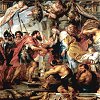Who was Mechizedek and what did Rubens believe?
Introduction:
Throughout the ages, scholars have tried to figure out who this mysterious person Melchizedek was (is). Some believe that he was (is) the pre-incarnate Christ, or even the son of God.
From early times until today:
The identity of Melchizedek has been the subject of much debate over the centuries. Some have claimed he was a theophany, others a literal human being, an angel, the pre-incarnate Christ, the son of God, Shem, and the list of speculation goes on. In rabbinical literature, Melchizedec was said to be from the lineage of Shem. The same literature also says Melchizedek's priesthood was taken from him because he blessed Abram before he blessed God.
Many early Christians also believed that Melchizedek was a pre-incarnate appearance of Christ. “Mark the Hermit” of the fifth century, “Theodotus the Banker,” and his sect known as the “Melchizedekians” or “Athingani” (whose descendants are the modern day Roma Gypsies) existed in the early centuries. These Melchizedekites regarded Melchizedek as a great heavenly power and as a son of God, superior to Jesus.
Traditional Christian denominations, following Luther, teach that Melchizedek was a historical figure and an anti-type of Christ. However, some Christians have taught that Melchizedek was an appearance of the pre-incarnate Christ. Some say that Melchizedek is literally like the Son of God (or even is the Son of God) in that he has no father or mother.
The Vatican website has 42 sermons, where Melchizedek is mentioned. In one he is called a "pagan" and in another "divine". Even Pope John Paul II struggled with the identity of Melchizedek. He calls him "a mysterious figure" in one of his papal papers. And he also states: "Christ's messianic task is symbolized by the figure of Melchizedek. An evident witness of this truth is found in the Eucharistic sacrifice which by Christ's institution the Church offers every day under the species of bread and wine, after the order of Melchizedek."
What does today's Bible say about Melchizedek?
In Genesis.
After rescuing his nephew Lot from military capture, Abram, whose name was later changed to Abraham, encountered Melchizedek. "Then Melchizedek king of Salem brought out bread and wine; he was the priest of God Most High. And he blessed him and said: 'Blessed be Abram of God Most High, Possessor of heaven and earth; and blessed be God Most High who has delivered your enemies into your hand.' And he [Abram] gave him a tithe of all" (Genesis 14:18-20).
In Psalms of David
Speaking prophetically of the Messiah, David stated: "The Eternal hath sworn, and will not repent, Thou art a priest forever after the order of Melchizedek." This verse is quoted again in Hebrews 5:6
Definition of "order": Greek "aphomoioo" (a) A facsimile (b) An exact copy or exact reproduction (c) A duplicate.
In the letter to the Hebrews
There are three chapters (5, 6 and 7) where the author talks about Jesus and Mechizedek.
In Hebrew 5:6: "You [Jesus] are a priest forever, in the order of Melchizedek."
In Hebrews 5:9, 10 the writer points out that Jesus has become "the source of eternal salvation to all who obey him, and he was designated by God as high priest in the order of Melchizedek."
Then in Hebrews 7:1, 2, the author goes on "This Melchizedek was king of Salem and priest of God Most High. He met Abraham returning from the defeat of the kings and blessed him, and Abraham gave him a tenth of everything. First, his name means "king of righteousness"; then also, "king of Salem" means "king of peace."
Verse 3 describes Melchizedek as being "without father, without mother, without genealogy, having neither beginning of days nor end of life, but made like the Son of God, [and one who] remains a priest forever."
Read more about these letters here. You can feel the anger and frustration of the writer as he tells his readers that they are lazy, stupid and need to grow up.
Dead Sea Scrolls
Interestingly, there is a Dead Sea scroll that identifies Melchizedek as "the one who will carry out the vengeance of God's judgments and the one who delivers the people from the hand of Belial and the spirits of his lot". Read more here.
The Bible in Rubens Days
In the first half of the sixteenth century the arrival of a new bible translation, which bore the unmistakable influence of Luther’s work, was of great concern to the Mother Church. Counteracting the printing of such bibles proved impossible. They realized that the reform could not be served better than to withhold the bible to the people. It was recognized that the best means was to render a good bible translation themselves. In 1548 an authorized translation appeared in Leuven (Louvain) in the Southern Netherlands.
This bible employed the text of the Vulgate. It followed the decision of the Council of Trent regarding bible translation, which ruled that the text of the Vulgate was the only recognized text. Afterwards in 1592, the definitive text of the Vulgate was established. The first Leuven bible translation was superseded and in 1599 there appeared the Moerentorf bible, named for the printer Jan Moerentorf at Antwerp.
Up to the beginning of the twentieth century, this latter bible was employed as a standard translation for Roman Catholic bible readers.
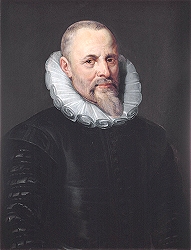 Jan Moerentorf Oil Painting by Rubens Click pic to enlarge |
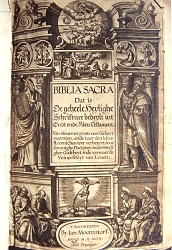 Moerentorf Bible 1599 The only bible approved by the Catholic Church. Click pic to enlarge |
Jan Moerentorf (a.k.a. Jan Moretus) (Antwerp, 1543 – 1610) was a Flemish printer. Moerentorf married the second daughter of the famous Antwerp publisher Christoffel Plantijn in 1570. He had been working for Plantijn since he was 14 years old, and after Plantijn's death, Moerentorf would become the owner of his printing company. They not only published religious works (both Catholic and Protestant) but also the works of humanist scholars and music. They printed editions of the Bible in Hebrew, Latin and Dutch, and were renowned for their beautiful execution and accuracy.
Moerentorf was a good friend of Peter Paul Rubens. Rubens painted most of his family members and illustrated several of his books.
It is fair to say that Rubens must have had the Moerentorf bible at home. Maybe even some copies of the Protestant bibles, which his friend printed.
So, what does the Moerentorf bible say about Melchizedek ?
Genesis 14:18  Translation: But Melchizedek, the king of Salem, brought forth bread and wine. And he was the priest of God Most High. Side margin reference: Hebrew 7.a.1. |
||
Hebrew 7.a.1. 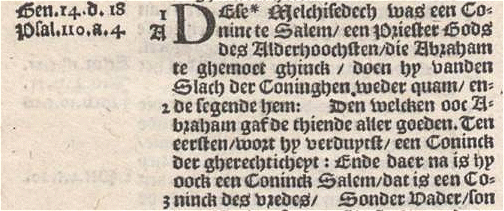 Translation: This Melchizedek was king of Salem, a priest of God Most High, who met Abraham returning from the defeat of the kings and blessed him. After which Abraham gave him a tenth of all goods. First, his name means "king of righteousness"; after which he is also, "a king of Salem", that means a "king of peace. Without father, without mother, without genealogy, having neither beginning of days nor end of life, but made like the Son of God, and one who remains a priest forever. Side margin reference: Genesis 4:18 (see above) and Psalm 110.a.4. |
||
Psalm 110.a.4. |
In another edition of a Southern Netherlands bible (not the Moerentorf) there are two side margin notes next to Genesis 14:18 |
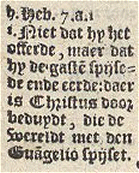 |
Conclusion:
Rubens may have studied many bibles, but definitely his friend Moerentorf's bible, which was first published in 1599. It was the only bible approved by the Catholic Church.
The above relevant, Olde Dutch, original texts show what was printed about Melchizedek. It was exactly the same as in today's bibles. Since the Catholic Church (then and now) does not recognize Melchizedek as the son of god, we must conclude that Rubens (and Infanta Isabella) sees in the gesture of the king-priest Melchizedek, who "brought out bread and wine," a prefiguring of Christ's own offering.
Willem van Osnabrugge
November19, 2011
